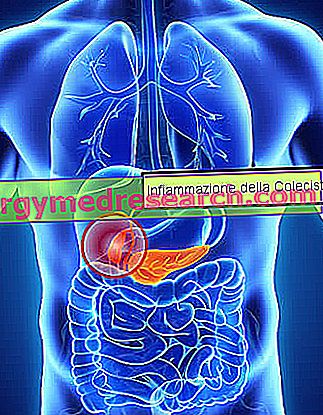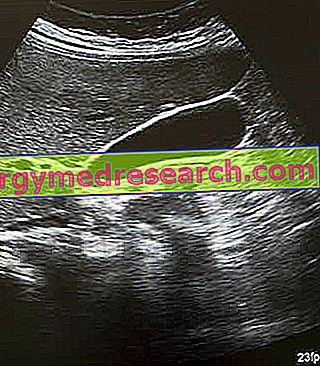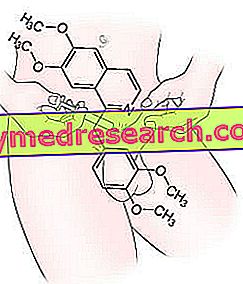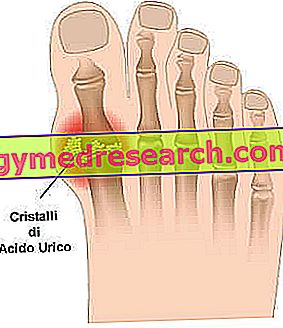PLEASE NOTE: In the medical report, the term alitiasic gallbladder indicates the finding of a gall bladder with no stones, without signs of inflammation.
If, on the other hand, the calculations are absent but the gall bladder is inflamed, one speaks more correctly of alitiasic cholecystitis .
It follows that using the term "alitiasic gallbladder" to indicate an inflamed gall bladder in the absence of stones is incorrect.
Generality
Alitiasic cholecystitis is an acute inflammation of the gallbladder, which occurs in the absence of gallstones.

In many cases, alitiasic cholecystitis represents a complication of various other medical or surgical conditions, such as infections, prolonged fasting, severe trauma, burns, diabetes mellitus, atherosclerosis, systemic vasculitis and immune deficiencies.
Gall bladder (or gallbladder): what it is for
The gall bladder (or gallbladder) is a small pouch-shaped organ that connects, via the biliary tract, to the duodenum (ie the first tract of the intestine).
Its task is to collect bile, a dense yellow-green substance, which is produced by the liver to allow digestion and fat absorption.
The main symptom of alitiasic cholecystitis is a very strong and prolonged pain located in the upper right part of the abdomen . This sensation tends to gradually increase and is usually accentuated when you press on the part and when the person takes deep breaths. Pain can also radiate to the scapula and back.
Although the clinical picture is sometimes insignificant, alitiasic cholecystitis is a serious condition, due to the rapid progression to gangrene and organ perforation .
For this reason, once the diagnosis is made, the alitiasic cholecystitis should be treated immediately, with surgery (cholecystectomy) and drug therapy.
A few notes
- The alitiasic gallbladder should be more properly defined as " alitiasic cholecystitis ", that is inflammation (as indicated by the ending - ite ) of the gallbladder (synonymous with gallbladder);
- The term " alitiasica " means " without calculations ". The cholecystitis is, in fact, one of the most frequent complications of these concretions (in this case, we speak of the lithiasic form). If the gallstones end up obstructing the cystic duct - that is, the channel that connects the gallbladder to the common bile duct (a conduit that carries bile to the duodenum) - the bile cannot escape and stagnates in the gall bladder. The bile salts therefore exert an irritating action on the walls of the organ.
- The acute halitiasic cholecystitis occurs less frequently than the "shape with stones" (it constitutes about 2-15% of the cases), but, compared to the latter, it represents a more serious pathology.
What's this
Alitiasic cholecystitis is a serious inflammatory disease of the gallbladder, not associated with the presence of gallstones.
The pathogenesis of this condition is multifactorial and depends on the release of enzymes and mediators of inflammation, secondary to stasis phenomena, increased lithogenicity of bile, ischemia or atony of the gallbladder wall.
Causes
Alitiasic cholecystitis is strongly associated with various clinical conditions:
- Biliary stasis;
- Bacterial proliferation;
- Ischemia of the gallbladder;
- Atonia of the gallbladder wall.
These conditions or their combination cause a local inflammatory response in the gall bladder wall. The lesions resulting from this process involve the concentration of bile salts and the distension of the organ, up to the necrosis of the gallbladder tissues. Perforation occurs in the most severe cases.
In the pathogenesis of alitiasic cholecystitis, feverish states, dehydration and heart failure may also play a role.
Risk factors
The risk factors that can predispose to the onset of alitiasic cholecystitis include, in particular:
- Severe abdominal traumas;
- Prolonged fasting;
- Very severe burns;
- Prolonged periods of assisted breathing and artificial parenteral nutrition;
- Consequences of major surgery;
- Diabetes mellitus;
- Atherosclerotic disease;
- Systemic vasculitis (eg polyarteritis nodosa);
- Systemic lupus erythematosus;
- Acquired immunodeficiency syndromes;
- Infectious diseases (eg salmonellosis or cytomegalovirus infections in immunosuppressed patients);
- Sepsis;
- Twist of the gallbladder;
- Various neoplastic processes.
This form of cholecystitis tends to occur above all in debilitated or critical patients (intubated or sedated), admitted to intensive care units and subjected to total parenteral nutrition (in which, that is, oral food intake is practically zero for more than 3 months).
Furthermore, alitiasic cholecystitis can be observed in patients with human immunodeficiency virus (HIV) infection, although it is a late manifestation.
Symptoms and complications
Symptoms
The alitiasic cholecystitis manifests itself with symptoms similar to those of the acute inflammation of the gall bladder induced by gallstones (lithiasic cholecystitis). Therefore, the disease can cause intense and continuous pain in the upper right part of the abdomen . In general, the sensation is similar to that of a biliary colic, but it has longer duration (it can remain constant even for half a day) and gravity (it is almost unbearable). The pain is accentuated, then, when you press on the painful part and when the person takes deep breaths, sometimes radiating also to the right shoulder blade and to the back.
Other frequent manifestations are also nausea, lack of appetite and vomiting . At the patient's ultrasound assessment, edema of the gallbladder wall is typically observed and, at subsequent checks, a progressive abdominal distension .
Complications
In the absence of a diagnosis and appropriate treatment, the alitiasic cholecystitis can rapidly progress to necrosis and gangrene of the organ. The consequences of this are the perforation of the gall bladder, which causes the spread of the infection in the abdomen ( peritonitis ), formation of abscesses, sepsis, and shock. Finally, inflammation of the pancreas ( pancreatitis ) is possible.
The clinical presentation of alitiasic cholecystitis is variable and often depends on the underlying predisposing conditions. In some cases, an unexplained fever and vague abdominal pain may be the only signs associated with inflammation.
In such cases, insidious presentation is associated with a high incidence of gangrene and gallbladder perforation.
If it is not treated appropriately, alitiasic cholecystitis can cause death. Complications are more likely in older patients with a high white blood cell count (leukocytosis).
Alitiasic cholecystitis: signals to watch out for
- Intense and prolonged pain in the upper right quadrant of the abdomen;
- Temperature;
- Nausea and vomit;
- Chills;
- Abdomen stretched out and hard.
Diagnosis
The diagnosis of alitiasic cholecystitis is formulated on the basis of medical history, physical examination, blood test and ultrasound of the abdomen.
- Blood tests do not provide a specific indication for the disease. However, in the presence of alitiasic cholecystitis an alteration in the values of white blood cells ( leukocytosis ) can be found, in addition to the increase in fibrinogen, bilirubin (total and direct) and gamma glutamyl transferase. Other parameters help to identify some complications (for example: the increase in lipase or amylase is indicative of pancreatic inflammation).
- Abdominal ultrasound is the first choice instrumental investigation in the case in which alitiasic cholecystitis is suspected. On ultrasound examination, the walls of the gall bladder appear thicker than the norm, with a dangerous effusion (presence of liquids around the gall bladder). At the same time, ultrasound allows the examination of the liver, pancreas, kidneys and biliary tract.

- On examination , Murphy's sign often appears (abrupt interruption of a deep inspiration following a bi-digital pressure carried out by the doctor on the patient's gallbladder point). In addition, in the case of peritoneal irritation, the Blumberg sign may appear.
Palpation of the patient's abdomen can reveal a mass in the upper quadrant and, in some cases, the visit highlights the presence of a secondary jaundice due to partial biliary obstruction. This last sign is caused by an inflammation that extends to the common bile canal.
When the diagnosis of alitiasic cholecystitis is established, immediate intervention is indicated due to the high risk of rapid deterioration and perforation of the gall bladder.
In patients who can tolerate surgery, cholecystectomy is the definitive treatment of alitiasic cholecystitis.
Therapy
Mortality in patients with alitiasic cholecystitis is influenced by the rapidity of diagnosis and strongly depends on coexisting medical conditions. Treatment must be instituted promptly and usually requires hospitalization. For a few hours, the patient is left on an empty stomach and is only fed through a drip or nasogastric tube.
The treatment of alitiasic cholecystitis generally involves the use of antispasmodic drugs, antibiotics, hepatoprotectors and analgesics. Furthermore, it is possible that cold packs are carried out on the region affected by the disease.
In many cases, as soon as the symptoms improve, the patient suffering from alitiasic cholecystitis is subjected to cholecystectomy (removal of the gallbladder). If a complication is suspected, such as the formation of an abscess or the perforation of the gallbladder, it is necessary to intervene surgically.
Can you live without gall bladder?
The gallbladder is not a vital organ, therefore its removal allows an almost normal life. In the case of cholecystectomy, the body adapts to the new situation: the bile necessary for digestion can pass directly from the liver to the first part of the intestine, even in the absence of its main deposit, continuing to perform its function.
In any case, after surgical removal, it may be useful to limit the consumption of fatty foods, to avoid abdominal pain and minor annoyances.




